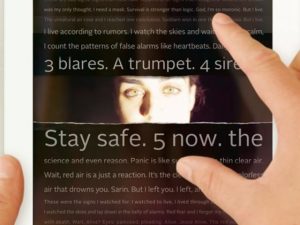Why Interactivity is Pry’s Greatest Strength… and Weakness
There are few concepts that resonate quite as strongly with today’s technological society as does the idea of interactivity. Gone are the days in which being the consumer meant also relegating oneself to the status of passive observer. Instead, the digital revolution of the last few decades has witnessed a growing emphasis on product-user interaction, with mediums such as videogames, virtual reality and social media all coming to the fore of pop-culture. However, the new and exciting capabilities of digital innovation are not just limited to these examples, and even literature has gone through a technology-induced metamorphosis as a result.
Released by art collective Tender Claws in June 2017, Pry is a digital novella that showcases the unique features of a fictional story told through a touchscreen interface. This ambitious literary project stands as the perfect example of how modern technology opens the door for innovative methods of storytelling. But beyond this, Pry exhibits the potential for highly interactive mechanics to overshadow the significance of the very text through which they navigate.
Set six years after his return from the Gulf War, Pry is narrated by the main character James as he struggles to adjust to life after service. With his eyesight slowly failing, and his mind plagued by harrowing memories, the story is largely presented from James’ own perspective through a unique amalgamation of text, video and audio. The way in which Tender Claws’ Danny Cannizzaro and Samantha Gorman blend these different elements is nothing short of captivating. But what truly sets Pry apart from other forms of digital fiction is the touchscreen interface that allows one to explore the different levels of James’ psyche. The main interaction that the reader has with this story is to pinch the screen in order to open or close the main character’s eyes. This gives the reader freedom to witness the real world in front of James; to close his eyes and read the narration within his mind; and to delve even deeper into his subconscious and observe the thoughts that constantly gnaw away at him. A good example of this three-tiered perspective representing some poignant psychoanalysis occurs in chapter two, as James oversees a controlled demolition. Closing his eyes, the reader can see that the explosions trigger in James a significant memory from the Gulf War. Prying further into his subconscious, the reader witnesses a series of military strikes accompanied by the sound of explosions as the demolition continues before him.
The demolition sequence is one of the more vivid scenes of PTSD affecting the main character, and it does not involve any text. Interestingly, text generally takes a back seat throughout this novella, with interactive gestures being the main focus for the reader. For this reason, it can be difficult to remain invested in the narrative of Pry, as: “the more interactive, the less immersive the text” (Ryan, Immersion vs. Interactivity, 1994). The interactivity of Pry is, in itself, an effective metaphor for exploring the mind. However, such a mechanical interface demands subsequent readings in order to fully appreciate the story.



